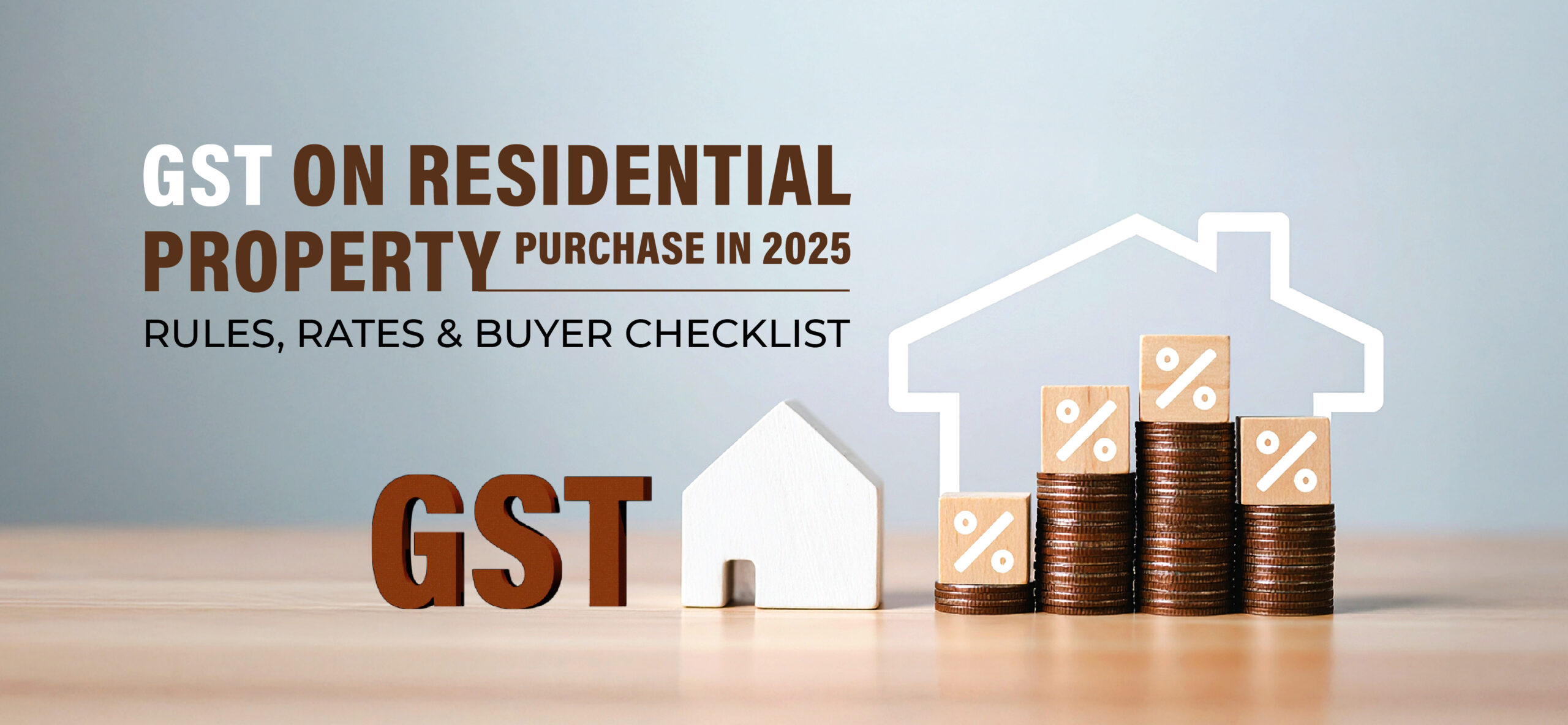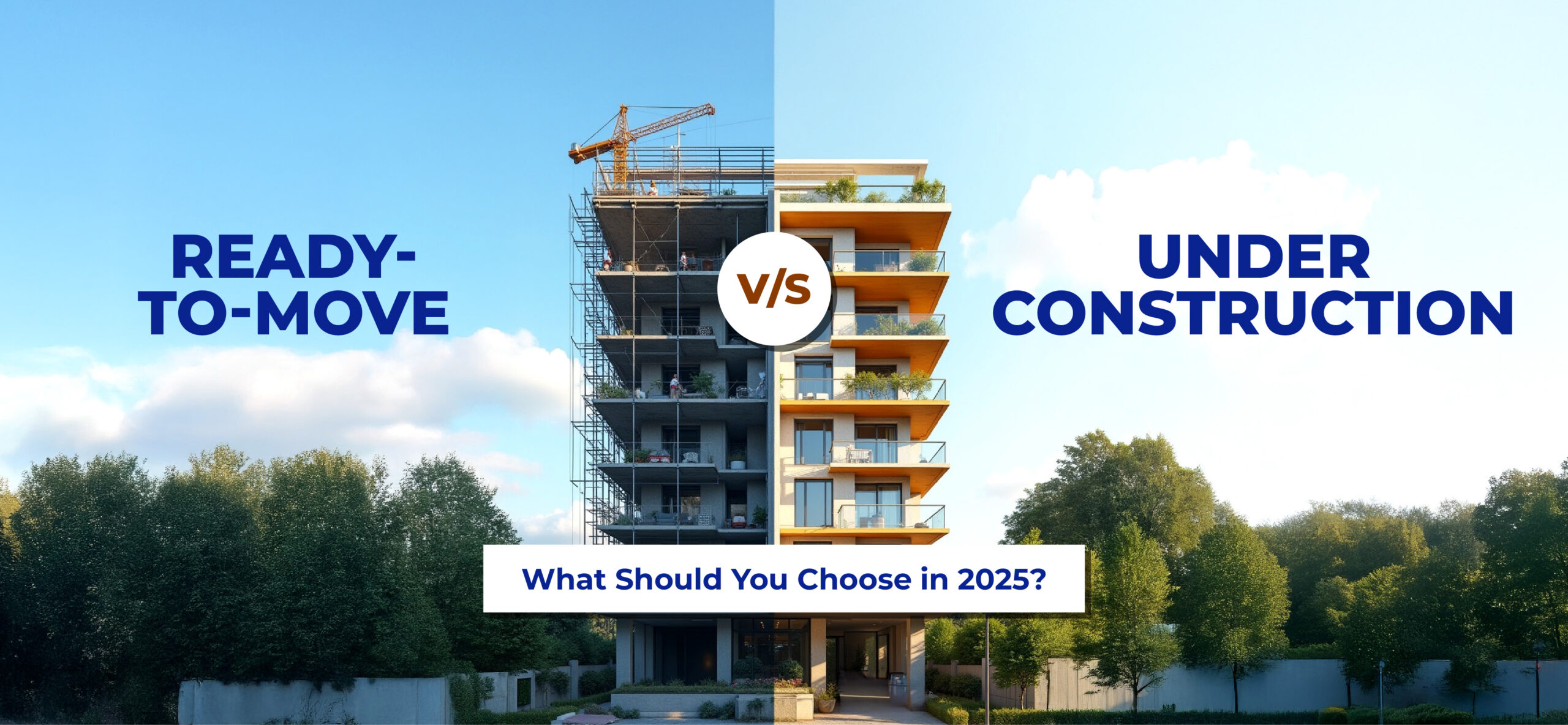Buying a home in 2025 means juggling many numbers—loan amounts, EMIs, stamp duty, registration fees, and, if the property is under construction, Goods and Services Tax (GST). It’s easy to underestimate how much this one tax can shape your overall cost. While GST on real estate has been around for years, the way this property tax applies to residential purchases today still catches buyers off guard.
If you’re in the market for a home this year, understanding the GST rules is essential. This guide breaks down the tax rates, clarifies where GST fits into the transaction, and highlight the property check every buyer should make before signing an agreement.
GST Rate Table for Residential Property – 2025
| Property Type | GST Rate | ITC Available? | Applicability |
|---|---|---|---|
| Affordable housing (under CLSS or new) | 1% | No | Under-construction, incl. CLSS projects |
| Other under-construction residential property | 5% | No | Flats, apartments, bungalows under development |
| CLSS housing (booked before 2019) | 8% | Yes | Select ongoing projects under earlier GST regime |
| Works contracts (general) | 18% | Yes | Developer/contractor services |
Note: GST does not apply to resale property, land-only deals, or ready-to-move-in homes that already have an occupancy or completion certificate.
Why GST Still Matters
GST is a crucial part of the buying process. Yet it still influences the way developers price homes and how buyers plan their budgets. The clarity of having a single, upfront rate for under-construction properties is valuable. Before GST, buyers dealt with a patchwork of VAT, Service Tax, LBT, Octroi, and other state or local levies, often applied at different project stages.
Today, the lower 1% rate for affordable housing continues to be a powerful push for budget-conscious buyers and a reason developers keep launching projects in this segment. The 5% rate for other under-construction homes is higher but still simpler to calculate than the old system.
It’s important to note that GST reform hasn’t replaced every cost. Stamp duty rates and registration fees remain separate, determined by state governments. This means your “tax” on a home purchase isn’t just GST—you need to think about both GST and state charges when comparing properties.
How GST Applies in Real Homes
Under Construction Homes
If the property doesn’t yet have a completion certificate, GST applies. Affordable homes (those priced at ₹45 lakh or below and within the government’s size limits) are taxed at 1% without input tax credit. All other under-construction residential units are taxed at 5%, also without ITC.
For example, on a ₹50 lakh flat in an ongoing project (non-affordable category), GST at 5% means an additional ₹2.5 lakh on top of the base price—before factoring in stamp duty or registration.
Luxury Segments
Luxury properties have seen one of the biggest changes since the earlier GST structure. A ₹7,000 per sq ft home used to be taxed at 12%, significantly raising the buyer’s outlay. Now the rate is 5%. That’s a saving of ₹490 per sq ft. On a 1,000 sq ft apartment, the GST portion alone is ₹4.9 lakh less than before.
Works Contract Services and Add-Ons
GST doesn’t only apply to the main property cost. It’s also charged at 18% on certain services and extras billed by developers or contractors. These include:
- Fit-outs and interiors offered as part of the deal
- Clubhouse or amenity packages
- Landscaping services
- Parking facility charges, if billed separately
It’s easy to overlook these, but for large-ticket add-ons, the GST amount can be substantial.
What GST Doesn’t Cover
One of the most common buyer misconceptions is that GST replaced stamp duty and registration fees. It hasn’t. Those remain state-level charges and are calculated on the property’s agreement value.
- Stamp duty: Usually between 5-10% of the property’s value, varying by state and occasionally by the gender of the buyer or other factors.
- Registration fee: Typically 1% of the property value or a fixed sum set by the state.
These charges don’t come under the GST framework and are to be paid regardless of whether the property is under construction or ready to move in.
Buyer Tax Checklist – GST-Focused
Before committing to a purchase, run through these GST-related checks:
- Check the completion certificate status. If it’s issued, GST doesn’t apply.
- Confirm affordable housing classification. This requires both a price cap (₹45 lakh or less) and a size limit (up to 60 sq m carpet area in metros, 90 sq m in non-metros).
- Request a clear price breakdown. Ensure the GST portion is shown separately in the cost sheet or invoice.
- Ask about CLSS eligibility and rates. For older projects under the Credit-Linked Subsidy Scheme, the earlier 8% with ITC may still apply.
- Budget for non-GST charges. Include stamp duty, legal fees, parking, and any one-time maintenance deposits.
- Insist on GST-compliant invoices. This ensures transparency and prevents double taxation.
Tips for Smarter Planning
- Timing the purchase: Some buyers wait until the project is close to completion to avoid GST altogether. This can work, but be prepared for higher per sq ft rates as possession nears.
- Check the project’s GST regime: For developments launched before April 2019, ask if the builder opted to stay with the old 8%/12% rates (with ITC) or moved to the new 1%/5% system.
- Account for GST on services: It’s not just the price of property—charges for parking, clubhouse, brokerage, or legal work may all have GST applied. These can meaningfully change your cash flow at closing.
Example Scenarios
Scenario 1 – Affordable Housing Unit
- Property Price: ₹40 lakh
- GST Rate: 1% = ₹40,000
- Stamp Duty (State Avg 6%): ₹2.4 lakh
- Registration Fee (1%): ₹40,000
- Total tax and registration outlay: ₹2.88 lakh + GST ₹40,000 = ₹3.28 lakh
Scenario 2 – Non-Affordable Under-Construction Unit
- Property Price: ₹75 lakh
- GST Rate: 5% = ₹3.75 lakh
- Stamp Duty (6%): ₹4.5 lakh
- Registration Fee (1%): ₹75,000
- Total additional cost: ₹8.25 lakh before other expenses
These numbers show why GST awareness is essential—not just for budgeting, but for comparing projects on a true like-for-like basis.
How to Approach Developers About GST
When discussing GST with a developer, keep the conversation focused and factual:
- Ask for the exact GST rate they are applying and on what amount it is calculated.
- Clarify whether all extras (parking, floor rise, club membership) are GST-inclusive or GST will be added separately.
- Request written confirmation of the GST calculation method in the agreement.
Conclusion
GST has simplified tax calculation on residential property purchases, but it hasn’t removed every complexity. Knowing when it applies, which rate you fall under, and what it doesn’t cover can help you avoid surprises at payment time. In 2025, the biggest advantage for buyers is transparency—if you take the time to ask the right questions and read the fine print.
The decision between an under-construction and a ready-to-move-in property isn’t just about possession timelines—it’s also a tax decision. Understanding how GST fits into the bigger picture of home buying costs can make your purchase both financially and strategically sound.
Looking for your next home?
Use BeyondWalls’ property records to search and compare projects across Pune. Get free first loan and financial consultation and plan your purchase with confidence.


